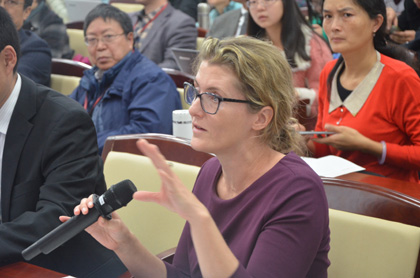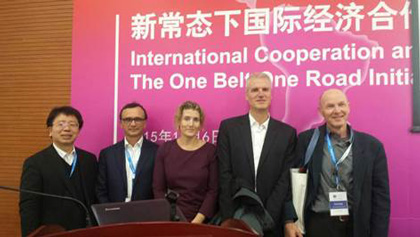 >Home>
SEPKU News
>Home>
SEPKU News
In the morning of November 7th, the parallel session 2 “Upgrading and Transformation of Regional Industrial Clusters in Global Value Chains” of the panel session “International Cooperation and Development in the New Normal: The One Belt One Road Initiative” of the Beijing Forum (2015) was held in Meeting Room 606, School of Economics at Peking University. The session was divided into 2 parts, and chaired by, respectively, Professor Canfei He from College of Urban and Environmental Sciences and Professor Hui Zhang from School of Economics at Peking University. Totally six speakers gave talks in this session. They are Professor David Rigby from University of California, Los Angeles, FloortjeAlkemade from Utrecht University, Jun Wang from Academy of Social Sciences in Guangdong Province, Ron BoBesides from Lund University and Marco Bellandi from Florenze University, besides Professor He.
Professor David Rigby analyzed the evolution of specialization in the EU15 knowledge space. Data shows that knowledge specialization has increased significantly across EU15 regions over time and it increases on average by 33% between 1981 and 2005, but varies substantially between technology sectors and regions. Overall, changes in technological specialization are driven equally by changes in entry of the region into new patent classes,and exit of the region from existing patent classes and selection. Finally, existing competences of regions and neighbors exert a strong influence on entry and exit of technology classes across regions.

FloortjeAlkemade tracks the internationalization of multinational corporate inventive activities. She argues that there exists heterogeneity in sectoral and national patterns of internationalization of R&D by multinational corporations in the period 1993-2005. However, these patterns have remained relatively stable over the 1993-2005 period. China is among the least internationalized countries and European countries.In contrast the UK and the Netherlands are among the most internationalized countries. The largest countries in terms of patent production, such as Germany and the US, have internationalization profiles that can be very well predicted based upon their sectoral composition. While national level indicators explain a large part of the variance observed in the ability of countries to attract R&D from foreign multinationals, there are significant differences between sectors and this has large implications for the design of foreign R&D and innovation policies.
Prof. Wang gave a presentation titled “Urban Scale, Population Density and Structural Dynamics”. He analyzed the tendency of industrial structure indicator among megalopolis, big cities and small-medium cities. The data shows that manufacture is the main industry exiting the megalopolis, while as for the big cities and small-medium cities, it is the main industry to entry. Therefore the megalopolis will be the engine of China’s industrial structure upgrading. At the same time, there will be a trend that China ends up with a series of urban agglomeration based on megalopolis, surrounded by big cities and small-medium cities.
Professor Ron Boschma talked about how regions diversify and which economic agents induce industrial changes. He found that there are lots of industrial changes in the industrial composition of Swedish regions, few structural changes and industrial changes balance out in the aggregate. Based on this, he demonstrated that incumbents reinforce the capability base of regions, new plants create employment in unrelated industries, and to survive, expanding firms depend less on related employment in the region than do entrepreneurs.

Professor Marco Bellanditook a trans-territorial and trans-sectoral perspective to local industrial development, that is, conceptual bases for processes of matching and bridging between roads of local industrial development in different countries. He demonstrated that industrial districts following a high road of local industrial development try to renew the accumulation of the national composite capital, based on reputational mechanisms, entrepreneurial pride, skill advance, good work, and related technological structures and social practices, and positive results have the nature of MEE supported by NCC in twinned clusters and places, including shared public goods specific to international trans-local exchanges and collaborative projects.

ProfessorCanfei Hetalked about how industrial evolution in China was based on both external factors and institutions. He examined the industrial evolution through the lens of entry and exit of four digit industries in the Chinese prefectures. He found significant evidence that regions branch into new industries which are technologically related to the existing industries and related industries are less likely to exit. Related globalization also encourages the entry of new related industries and discourages the exit of related industries. He concluded that economic transition has also generated opportunities for Chinese regions to create new paths of industrial development.